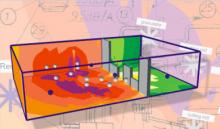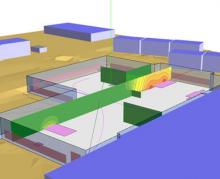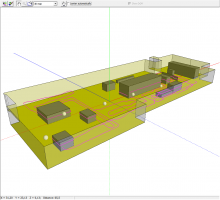|
Indoor Factory Noise Module - Modeling Inside to Outside The Indoor Factory Noise Module calculates the noise levels inside manufacturing rooms based opon VDI 3760. SoundPLAN unique implemented of VDI 3760 all the user to overcome the restrictions of this VDI guideline. It is possible to account for any room shape, local screening effects, and local absorption areas. The user has the ability to optimize sensible noise reduction measures like absorbers and screens in rooms with work places. The complete integration in the SoundPLAN software package takes advantage of the existing input and output capabilities. The input data such as source emission and surface absorption spectra can be organized in the project library. The system library already containing hundreds of 1/1 or 1/3 octave bands reference data. The computed results can be single values at working places, sound decay curves (Sound Propagation Curve), reverberation times (based on Sabine / Ehring) and horizontal and vertical noise maps. |
|
Cross-section noise map
A cross-sectional noise map in the factory with the roof removed and the walls semi transparent gives the viewer a much better understanding where the noise problems are in the factory. |
|
Sound Particle Modeling The Indoor Noise calculation provides a new calculation algorithm that is based upon a sound particle model that incorporates diffraction, scattering and sound transmission. With the new model SoundPLAN predicts the noise level inside the industrial building. The industrial building editor allows the user to define the interior surfaces in regards to the acoustic absorption and transmission. The user can add vertical and horizontal elements to model walls and floors inside the buildings. The user can add transmissive area to model doors, hallways, staircases and other open spaces. The source definition includes point, line, area and box shapes. Each of source can be defined with spectral sound power levels and time histograms. The Industrial building object is used for the interior noise model or for the source for a exterior noise model. The noise level predictions inside are used to predict the noise transmitted through the exterior walls and roof. The transmission loss for the walls, roof or other exterior elements are defined by the user. |
|
|



